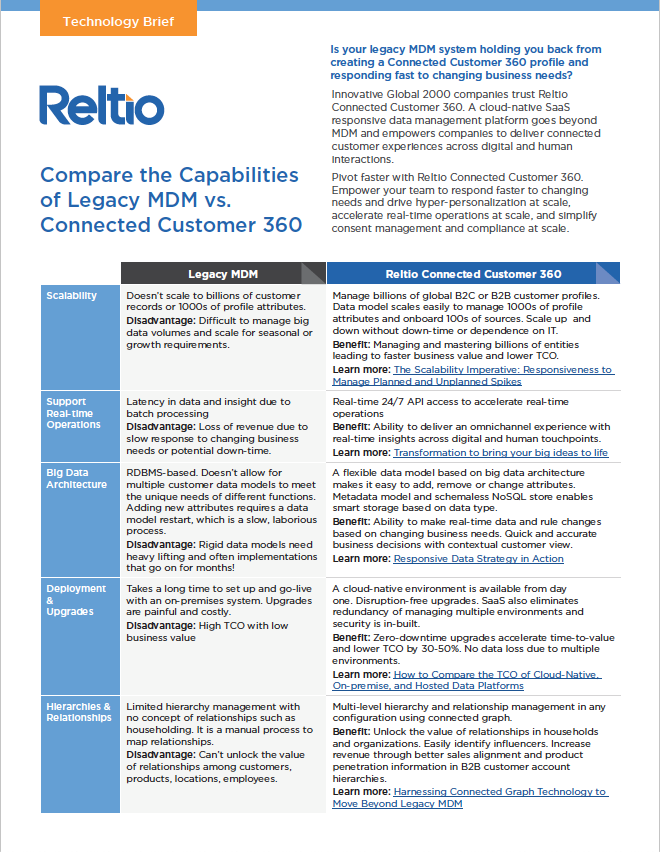Connected Customer 360 Profiles for Retail & Luxury Brands

3 Things Data Innovators at Retail & Luxury Brands Have in Common
Retail and luxury brand leaders may use different terms to describe customers, including “clients” or “guests.” But, the most innovative retail and luxury brand leadership teams have 3 common areas of focus when it comes to their customers:
- They focus on building long-term customer relationships. Innovative leadership teams recognize that their customer data is one of their most unique, differentiating and valuable assets. They believe in using customer data strategically. They are working together to bridge their customer data silos to create a company-wide customer data strategy. And, they are empowering their teams with access to unified, real-time, preference-rich and connected customer 360 profiles, including consent and communication preferences. They want to understand the “connections” between customers and their preferred channels, interactions, transactions, brands, products, store locations, websites, devices, and households. These “connections” are important data points for building close customer relationships and delivering exceptional services and experiences across digital and human interactions. That’s what Reltio Connected Customer 360 delivers – unified, real-time, preference-rich and connected customer 360 profiles.
- They focus on transactional consistency and operational optimization. Therefore, they use connected customer 360 profiles to power connected, hyper-personalized experiences across digital and human interactions. According to Forrester, by 2023, digital will impact 58% of total US retail sales — that is, sales for which customers do at least some part of their shopping journey via a digital touchpoint. In fact, the same Forrester report reveals that many retail and brand professionals believe their omnichannel programs have increased revenue (80%) and have improved profitability (72%), and 52% reported that their programs have driven their average order values (AOVs).
- They focus on analytical consistency and value optimization. As a result, they use connected customer 360 profiles to power analytics and data science initiatives to get deeper insights about their customers in-the-moment to fuel their innovation roadmap with differentiated products, services and digital experiences. According to Accenture, 71% of retail executives believe digital demographics are expanding the number of ways they deliver products and services. Technology-driven interactions are providing a new lens through which to understand how consumers engage (and want to engage) with technologies. Their digital fingerprints can guide retailers to invest in technology solutions consumers will welcome—and avoid those they won’t.
Retailers and luxury brands that invest in connected customer 360 profiles are achieving substantial returns: $2.2 million in cost, productivity and revenue improvements per year. A $560,000 lift in profitability per year can be achieved by simply improving consumer identification.

Customer Data Silos Lead to Disconnected Customer Experiences
While there’s a lot of great strategy work happening to improve customer experience in retail and luxury brands, often it’s happening in silos. And, there’s usually a huge, gaping hole in that strategy: customer data.
Take a look at the “Before” scenario below. These are the customer data silos of a retailer that’s undergoing a transformation. They are successfully shifting from a luxury department store to a luxury digital platform. When they started on their transformation, every department had a silo of customer data.
Every team was working really hard and trying their best, but because they lacked a company-wide customer data strategy and a responsive data management platform, they were at a huge disadvantage. Disjointed, disconnected, and outdated customer information was an obstacle on their roadmap to delivering connected, hyper-personalized customer experiences across digital and human interactions. While the needs for customer data had grown exponentially, their legacy master data management (MDM) and IT environment was holding them back.
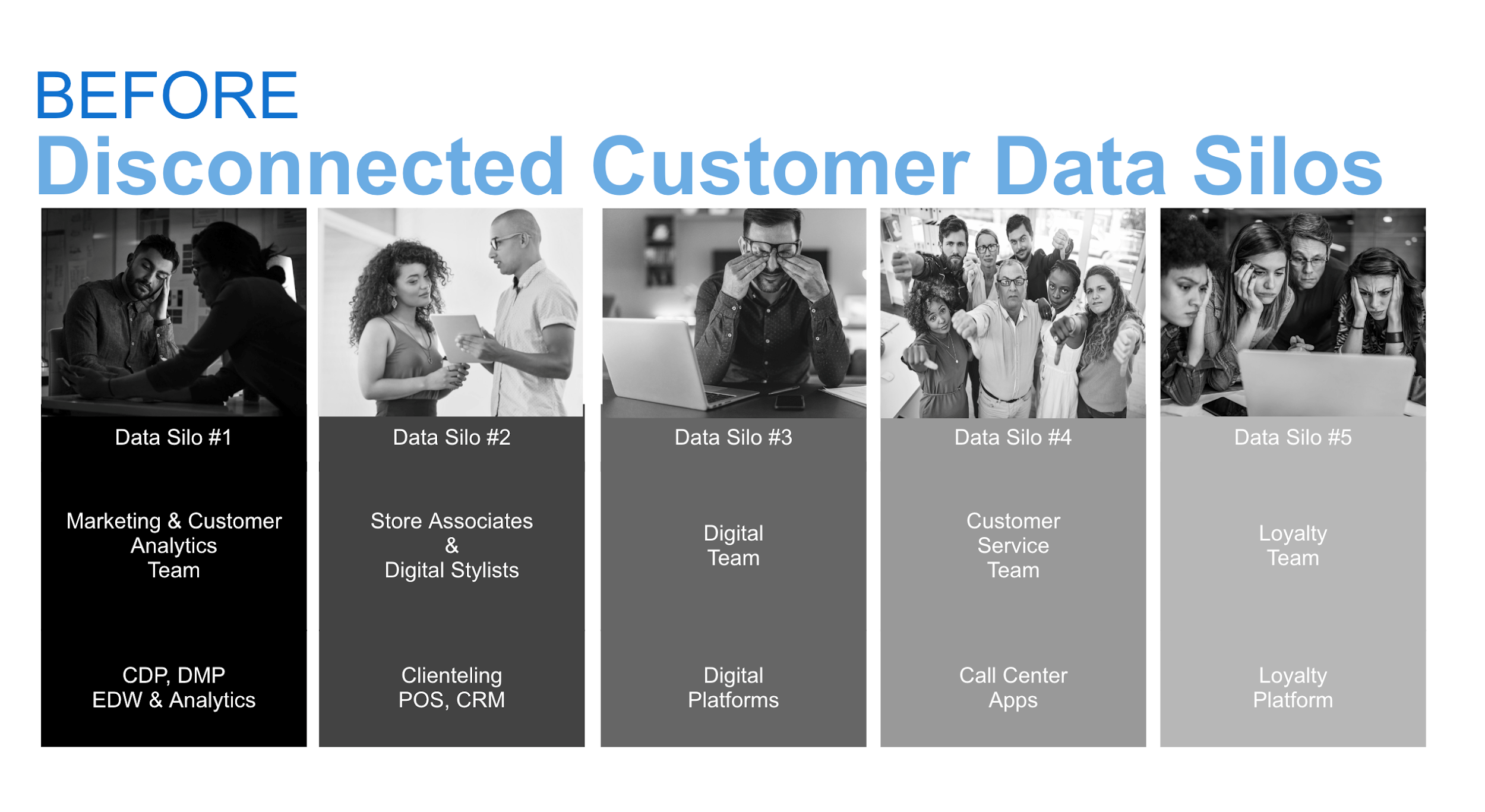
Retail & Luxury Brand Business Needs Mapped to Customer Data Challenges
Take a look at the table below. It maps MDM in retail industry and luxury brand business needs to their related customer data challenges. This can be a useful guide to data leaders and enterprise architects who work for retail and luxury brands and struggle to connect the dots between business requirements and data management solutions.
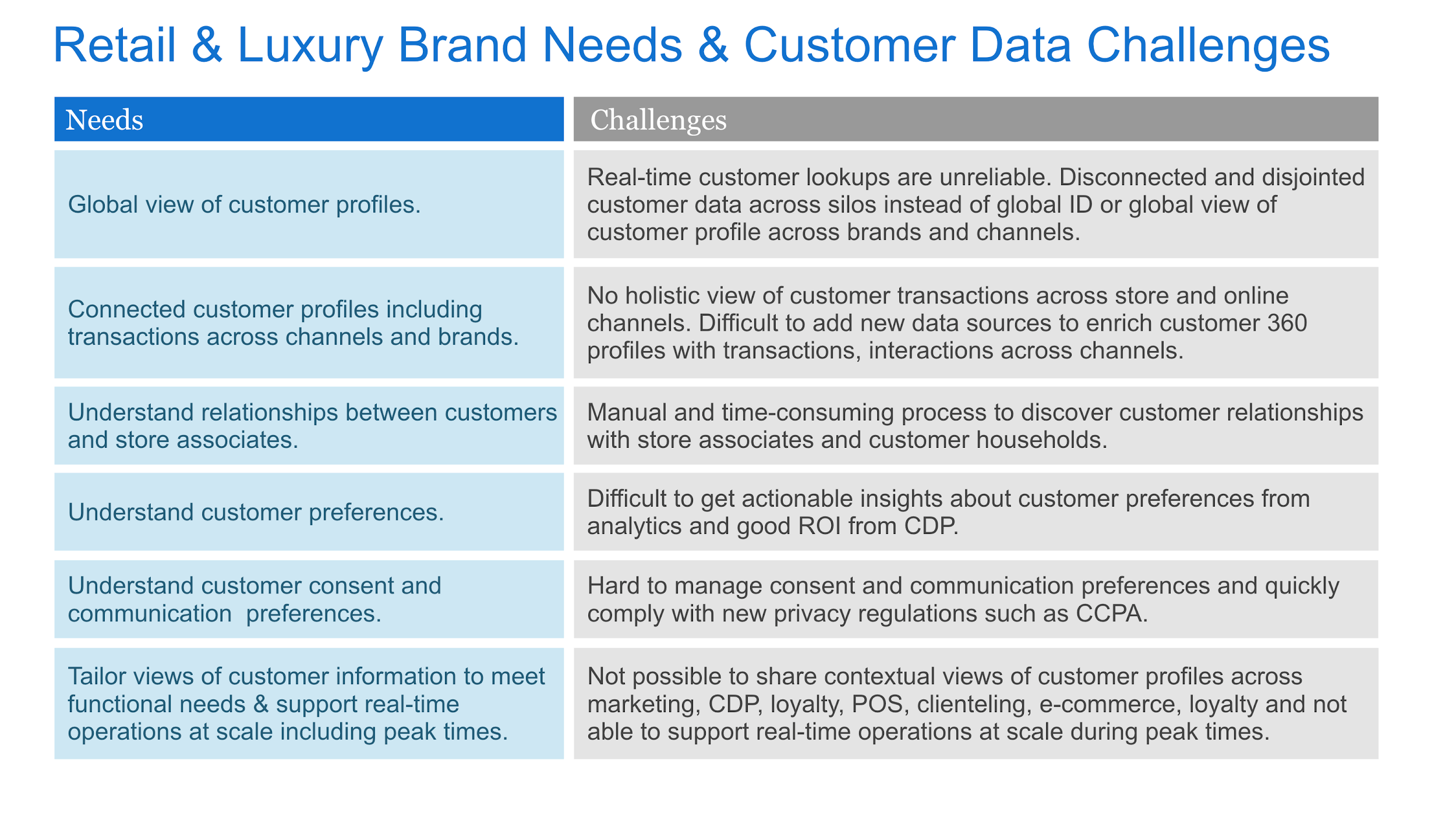
Without access to unified, real-time, preference-rich connected customer 360 profiles, including consent and communication preferences, powering their operations or their analytics, it was difficult to answer these basic questions:
- Is this customer lookup reliable? It was difficult to trust real-time customer lookups because many customers had duplicate profiles.
- Would this customer be interested in items prominently featuring brand logos? It’s not easy to find out without preference-rich connected customer profiles that include transactions across channels and brands.
- Can I SMS text a customer about these exclusive new items? It’s not clear without seeing the consent management and communication preferences in the profile.
- Which store associates have a relationship with this customer? There’s no easy way to discover relationships between customers and store associates or customers in a household.
- Will we be able to support real-time operations at scale during peak times with our new digital channel? This is difficult to do without access to real-time, preference-rich, connected customer 360 profiles that include consent and communication preferences.
- Will we get a good ROI on our customer data platform (CDP)? It’s unclear. If you don’t have a unified customer 360 profile, which takes into account transaction history across channels and brands, it’s difficult to get value from a CDP. A CDP needs unified, real-time, preference-rich and connected customer 360 profiles to activate tailored customer onboarding and customer journeys.
Retailers & Luxury Brands Can Benefit from Connected Customer 360 Profiles
See the image below that illustrates the “After” scenario for the luxury retailer. Reltio Connected Customer 360 supports the needs of all retail and luxury brand functions, including:
- Marketing & Customer Analytics
- Store Associates and Digital Stylists
- Digital Team
- e-Commerce Team
- Services Team
- Loyalty Team
It enables retail and luxury brands to deliver hyper-personalized connected customer experiences across digital and human touch points while respecting privacy and communication preferences.
- Enabling hyper-personalization at scale
- Accelerating real-time operations at scale
- Simplifying compliance and consent management at scale

Rob Fuller, Customer Data Orchestration Practice Lead at Accenture Interactive and I wrote a blog, Overcoming the 4 biggest challenges to Connected Customer Experiences in Times of Uncertainty and Beyond to help companies get started. It starts at the top with the C-Suite creating a vision for customer data. The vision translates into a customer data strategy and plan. It cascades throughout the organization through an understanding of the business requirements for customer data to power cross-functional processes, departmental processes and applications. It also impacts the requirements for the data management technology required to manage customer data as a company asset.
With the global pandemic, stores closed. It became even more important to get closer to customers and understand their changing needs. Having access to unified, real-time, preference-rich and connected customer 360 profiles became an advantage. This retailer was able to use this data to drive connected experiences across digital and human channels. With the Customer API powering their clienteling app, store associates were able to create curated assortments for their customers while they were working remotely. This resulted in $2M in sales per day while stores were closed. The ability to pivot fast with a responsive data management platform became a huge advantage.
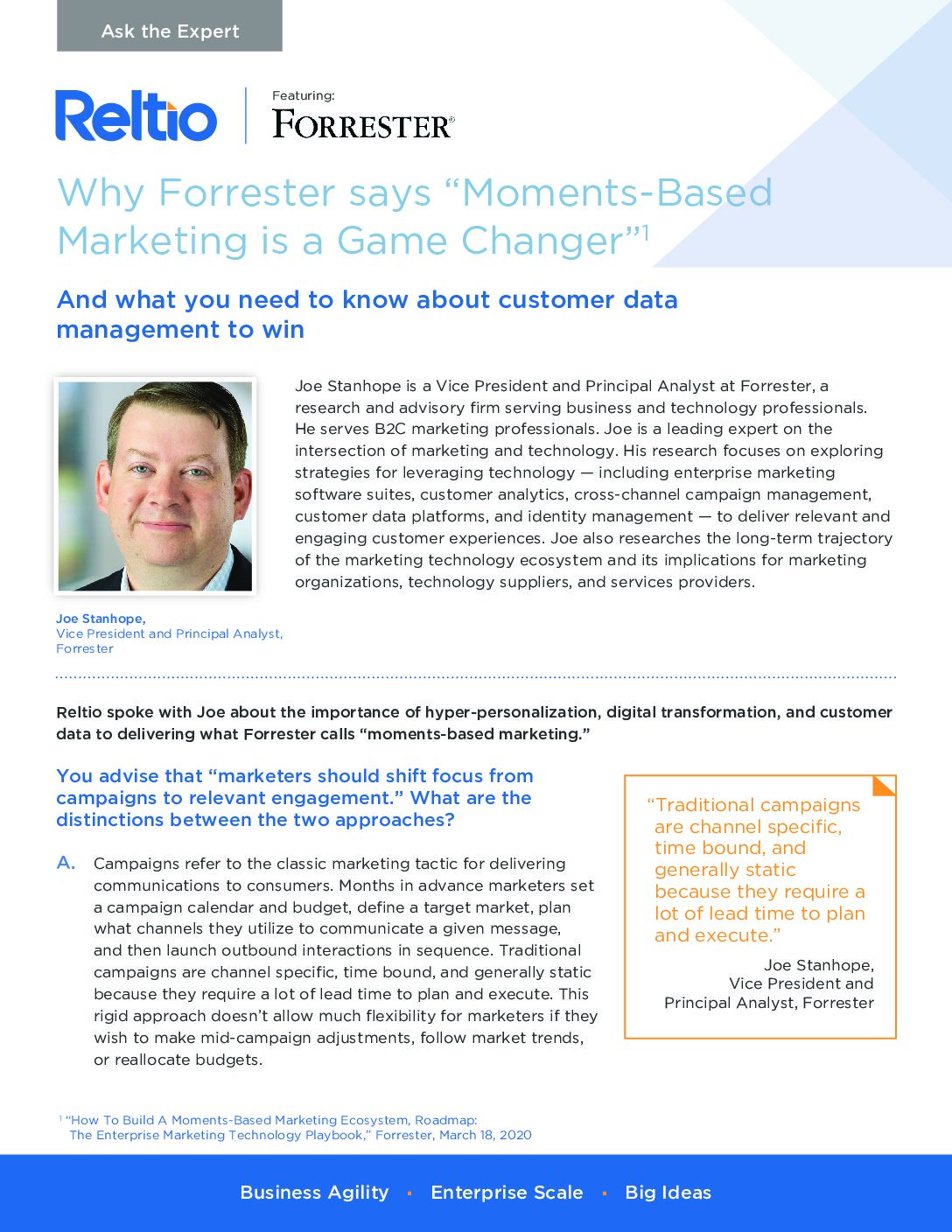 “Complete, accurate customer data can help improve customer service, customer experience, and inform offline decisions,” said Joe Stanhope, Vice President and Principal Analyst at Forrester and an expert in B2C marketing. “Firms need to update their approach to customer data management in two critical ways:
“Complete, accurate customer data can help improve customer service, customer experience, and inform offline decisions,” said Joe Stanhope, Vice President and Principal Analyst at Forrester and an expert in B2C marketing. “Firms need to update their approach to customer data management in two critical ways:
- fully leveraging customer data broadly across the complete experience from insights, targeting, personalization and delivery,
- developing a complete set of customer data to build robust customer profiles based on all available customer, company, and contextual information.
And customer data should not be limited to just the marketing department. It can provide tremendous value across the entire enterprise. Complete, accurate customer data can help improve customer service, customer experience, and inform offline decisions. For example, customer journey data can suggest the best strategy for email personalization, but digital findings can be used beyond email marketing to tailor customers’ in-person and in-store interactions.” To learn more, check this out: Forrester Q&A: Moments-Based Marketing is a Game Changer.
How Can Reltio Connected Customer 360 Help Retail & Luxury Brands?
Reltio Connected Customer 360 is a responsive data management platform built for the experience economy. It manages billions of unified, real-time, preference-rich and connected customer 360 profiles to power three mission-critical areas for retail and luxury brands:
- Real-time operations at scale for 1000s of users including scaling for peak times (for example, meeting customer demand during holidays, the launch of a new ad campaign or promotion or new product launch). This includes digital and human interactions.
- Analytics and data science initiatives to get deeper insights about their customers in the moment of engagement to fuel their innovation roadmap with differentiated products and services.
- Developing new apps and experiences using an API approach. Think of Reltio Connected Customer 360 as a recomposable Customer API that can support any use case. To make up for the customer data limitations of clienteling apps, some retailers are building relationship apps that are powered by a customer API. With Reltio’s API-first approach, you can inject intelligence and enrich data for any user, any application, across all touchpoints. In addition to internal apps that help employees, they also use this customer API to power new customer experiences. Rather than standing up another customer data silo, they connect these apps to their responsive data management platform.
Connected Customer 360 Profiles for Retail & Luxury Brands
Reltio Connected Customer 360 Profiles are enriched with 1000s of attributes for precise segmentation and hyper-personalization. While the process starts with a single view of the customer (SVOC), that’s only the beginning. There are six steps involved in building a unified, real-time, preference-rich connected customer 360 profile, including:

- Single Customer View: Start with the basics, but with a responsiveness that’s designed for the experience economy. Cleansing, matching, merging (and unmerging) customer data and any other data that’s important to your connected customer 360 profile, including employees, locations, products and channels. Unlike Legacy MDM systems, it’s easy to add, remove or change customer profile attributes and onboard new data sources to enrich customer profiles.
- Onboard All Data, including Omnichannel Transactions and Interactions: The best way to understand your customers and hyper-personalize offers and experiences is to access customer preferences based on transactions and interactions across functions, channels and brands. Unlike Legacy MDM systems, Reltio Connected Customer 360 makes it easy to onboard all data and it includes reference data management, free of charge.
- Unlock the Value of Relationships: For retail and luxury brands, long-term relationships are the key to success. However, legacy technology made it difficult to quickly access and unlock the value of relationships among customers, between customers and employees (eg. store associates and digital stylists), products and locations.
- Actionable Customer Insights from Data Science and Analytics: what makes Reltio Connected Customer 360 unique from any other system on the market is that you can deliver insight ready connected customer 360 profiles to analytical environments and then add those insights into your connected customer 360 profiles to make the information actionable. This includes important calculations such asL customer health, propensity to buy, propensity to churn and any other behavior and intent information that’s valuable.
- Consent & Communication Preferences: Retailers and luxury brand executives want to respect the preferences of their customers. However, with legacy technology, it’s often difficult to manage the complexity of consent and communication preferences across brands, channels and topics of interest. Connected Customer 360 Profiles enable you to do this and simplify compliance with GDPR, CCPA and future privacy laws.
- Contextual Customer 360 Profiles: Legacy technology serves up a one-size-fits-all approach to customer data. But that doesn’t reflect the business requirement of different stakeholders in the business. Marketing may want different information in their connected customer 360 profiles than the customer service or the loyalty teams. It’s important to be able to flexibly serve up different contextual views of customer 360 profiles to meet the different requirements of different functions.
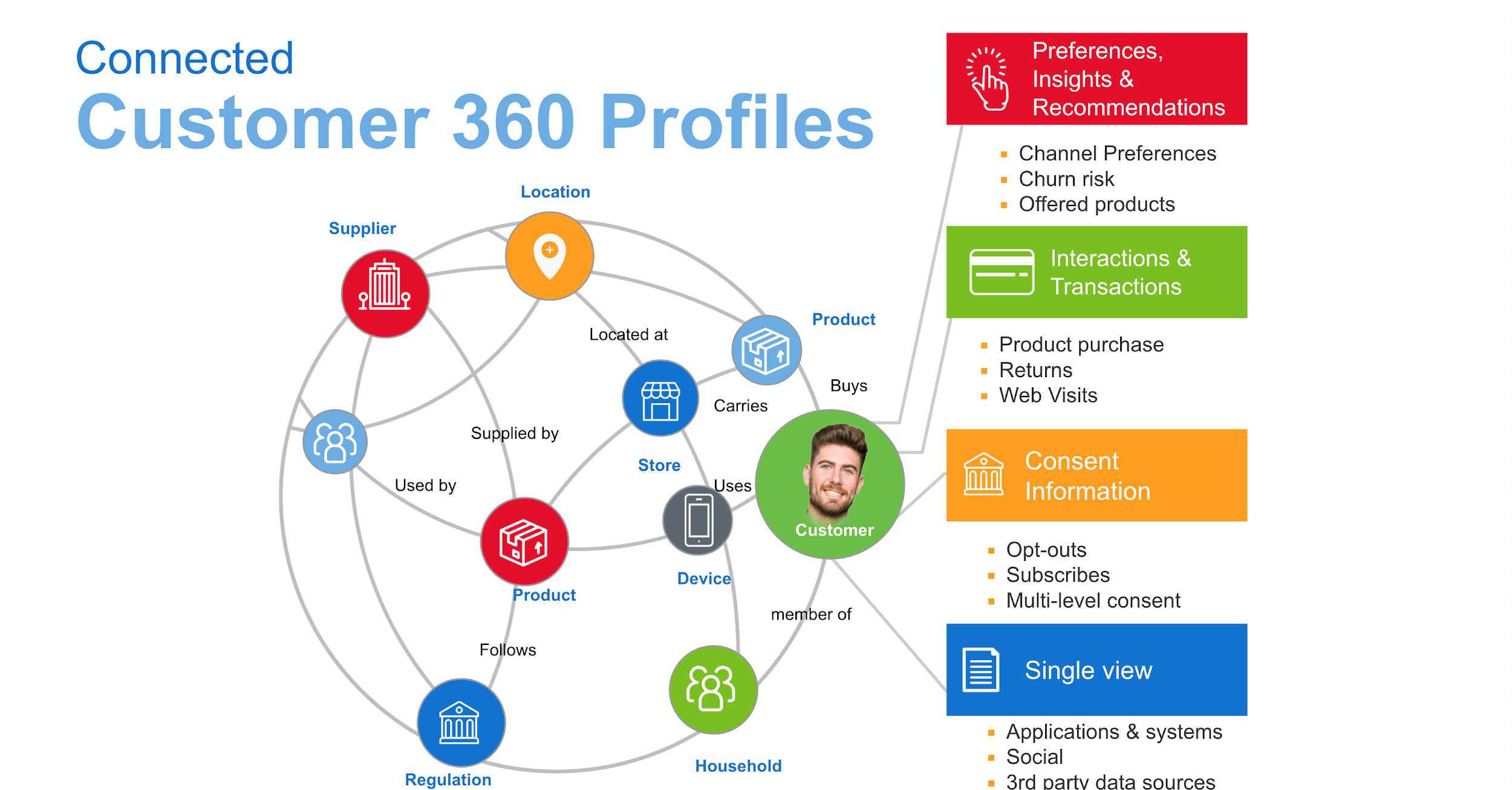
Compare Legacy MDM vs. Reltio Connected Customer 360 Profiles
Reltio Connected Customer 360 Profiles are managed in a highly secure and compliant cloud-native SaaS responsive data management platform. To understand the differences between the legacy MDM systems that some vendors claim to be cloud-native, check out this blog: What is TRUE Cloud-native Master Data Management?
Unlike Legacy MDM systems, Reltio Connected Customer 360 includes an ongoing stream of updates. It does not require upgrades that cost between $300,000 and $500,0000 and 9 months of the IT team’s time, resulting in no new business value. Unlike Legacy MDM systems, it includes a Customer Success Manager (CSM) who works with you to achieve business value milestones.
The goal of legacy MDM is to create a global customer record or single customer view (SVOC). It uses data integration, quality and consolidation to standardize key data elements such as first name, last name, mailing address phone and email address. It’s based on an RDBMS. The goal is to support efficient processes and avoid transaction failures. An SVOC is valuable, but not sufficient. For that, you need more than Legacy MDM.
Want to learn more about how you can move beyond legacy MDM to power your retail or luxury brand in real time at scale? See this Technology Brief to Compare the Capabilities of Legacy MDM with Connected Customer 360 Profiles. It covers the following topics:
- Scalability
- Support for Real-time Operations
- Architecture
- Deployment and Upgrades
- Hierarchies & Relationships
- Matching Capabilities
- User Interface
- Search & Segmentation Capabilities
- Ability to Manage Multiple Customer Data Models
- and more…
Boiling The Ocean vs. 90-Day Sprints to Deliver Business Value
Rather than trying to tackle a company wide customer data project that could last several years, data innovators understand the value of taking a phased approach. See this blog about the Top 6 Characteristics of a Data Innovator.
They work in 90 day increments and focus on delivering business value. They rollout capabilities that are aligned to delivering business value.
- One approach might be to roll out by function. In the example above, this retailer started by powering their CDP with connected customer 360 profiles. This helped the marketing team accelerate the return on investment from their CDP. The next function to benefit were the store associates. They powered their POS system with connected customer 360 profiles and used a customer API in their new relationship app. This allowed them to reach out to customers with relevant offers while working remotely during the global pandemic while stores were closed.
- Another approach might be to start with one data type such as customer. Then, connect that data with other data types such as store associates, locations, products, suppliers, etc. This gives visibility into the relationships between customers and their favorite stores, for example. In the example above, the retailer created unified, real-time store associate profiles to understand the relationships between customers and store associates. Which store associates did this customer work with to buy handbags? Which store associate did the customer turn to for shoes?
- Yet another way to drive business value is to add additional attributes to the customer profile. Perhaps start with the basics including consent and communication preferences. Then unlock the value of relationships. Then add transactions and interactions to understand preferences. Then add actionable insights from analytics or data science. For example, is this customer price sensitive? Is this customer a social media influencer?
Want to learn more?
In my next blog, I’ll share some retail and luxury brand case studies.

